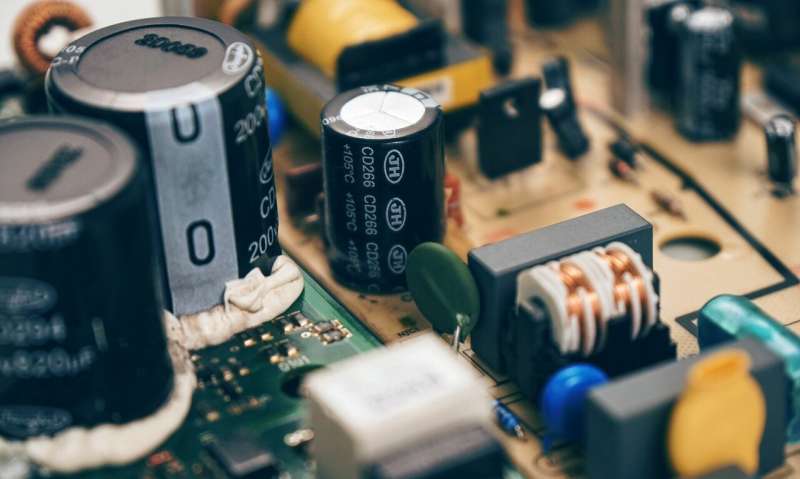2024-10-01 16:16:04
phys.org

A new model accounts for a wide range of ion-electrode interactions and predicts a device’s ability to store electric charge. The model’s theoretical predictions align with the experimental results. Data on the behavior of the electric double layer (EDL) can aid in the development of more efficient supercapacitors for portable electronics and electric vehicles. The study has been published in ChemPhysChem.
Many devices store energy for future use, with batteries being among the most well-known examples. They can consistently release energy, maintaining steady power output regardless of existing conditions or load, until fully discharged.
In contrast, supercapacitors deliver power in pulses rather than in a continuous flow. If a battery can be likened to a jar that gradually stores energy for long-term use, then a supercapacitor is like a bucket that can be filled and emptied rapidly. This means that a supercapacitor can store energy for a short duration and release it instantly in a large burst.
The power of a supercapacitor depends on its internal resistance, which is notably high. This enables the supercapacitor to operate with very high currents, almost similar to a short circuit. Such a system is helpful when a quick, powerful charge is needed, and it is used in cars, emergency power systems, and compact devices. This effect is made possible by the accumulation of energy in the supercapacitor through an electric double layer (EDL).
The ability of any capacitor to store charge is determined by the area of its plates, the distance between them, and the type of dielectric material used. Since the electrolyte layer between the plates of a supercapacitor is only a few nanometers thick, and the porous coating on the electrodes provides a large surface area, supercapacitors can significantly surpass traditional capacitors in terms of stored energy.
In real-world conditions, the electric double layer is influenced by chemical interactions occurring at the quantum level. Therefore, it is essential to study both the properties of the electric double layer and the factors that influence it to improve the efficiency of electrical devices.
Scientists at HSE MIEM and the Semenov Research Centre of Chemical Physics have developed a model to describe the electric double layer at the interface between an electrode and an electrolyte solution, using a modified Poisson-Boltzmann equation for calculations.
The model considers specific interactions between ions and with surrounding water molecules, the impact of an electric field on the dielectric properties of water, and the limited space available for ions at the electrode surface. This enabled a detailed description of the differential electrical capacitance profiles, measuring how effectively the EDL can accumulate charge as the voltage changes. The higher the differential capacitance, the more charge the layer can hold with small voltage changes.
The study examined aqueous solutions of sodium perchlorate (NaClO4) and potassium hexafluorophosphate (KPF6) at the interface with a silver electrode. The resulting model successfully predicted the structure of the electric double layer, providing insights into the capacitance behavior at various ionic solution concentrations. An important achievement has been the successful application of the model to mixtures of the said electrolytes, demonstrating its versatility and suitability for predicting the behavior of complex electrochemical systems.
“Our theoretical predictions perfectly match the experimental data. This is important because quantifying differential electrical capacitance during an experiment is not trivial and requires meticulous, time-consuming procedures,” comments Yury Budkov, Leading Research Fellow at the Laboratory for Computational Physics of MIEM HSE and one of the authors of the paper. This model will enable the prediction of differential electrical capacitance behavior in conditions where obtaining experimental data is difficult or impossible.
This is the first in a series of studies aimed at developing a comprehensive theory of the electric double layer at the metal-electrolyte interface as it relates to real-world systems. In the future, the authors plan to extend the model to include systems with stronger ion-electrode interactions, which are the most prevalent ones.
“Such a model will be able to account for additional factors that influence the operation of modern electrochemical devices. This is important for the development of new supercapacitors that can be utilized in a range of devices, from portable electronics to electric vehicles,” says Budkov.
More information:
Daria Mazur et al, Understanding the Electric Double Layer at the Electrode‐Electrolyte Interface: Part I ‐ No Ion Specific Adsorption, ChemPhysChem (2024). DOI: 10.1002/cphc.202400650
Provided by
National Research University Higher School of Economics
Citation:
Scientists develop a new model of electric double layer (2024, October 1)
retrieved 1 October 2024
from https://phys.org/news/2024-10-scientists-electric-layer.html
This document is subject to copyright. Apart from any fair dealing for the purpose of private study or research, no
part may be reproduced without the written permission. The content is provided for information purposes only.
Support Techcratic
If you find value in Techcratic’s insights and articles, consider supporting us with Bitcoin. Your support helps me, as a solo operator, continue delivering high-quality content while managing all the technical aspects, from server maintenance to blog writing, future updates, and improvements. Support Innovation! Thank you.
Bitcoin Address:
bc1qlszw7elx2qahjwvaryh0tkgg8y68enw30gpvge
Please verify this address before sending funds.
Bitcoin QR Code
Simply scan the QR code below to support Techcratic.

Please read the Privacy and Security Disclaimer on how Techcratic handles your support.
Disclaimer: As an Amazon Associate, Techcratic may earn from qualifying purchases.








































![Roblox Pressure | THE RAVEYARD [Full Walkthrough]](https://techcratic.com/wp-content/uploads/2024/12/1734837320_maxresdefault-360x180.jpg)








![[2024 Upgrade] INSAUTO Tesla Model Y Windshield Sunshade Umbrella-Protect Car from Sun…](https://techcratic.com/wp-content/uploads/2024/12/61aJHRkDWTL._AC_SL1392_-360x180.jpg)

















